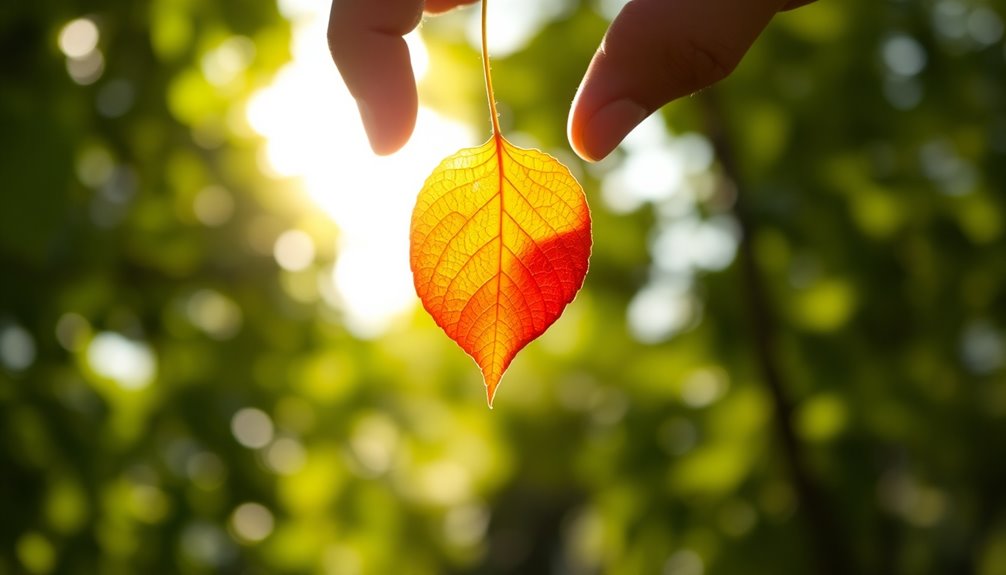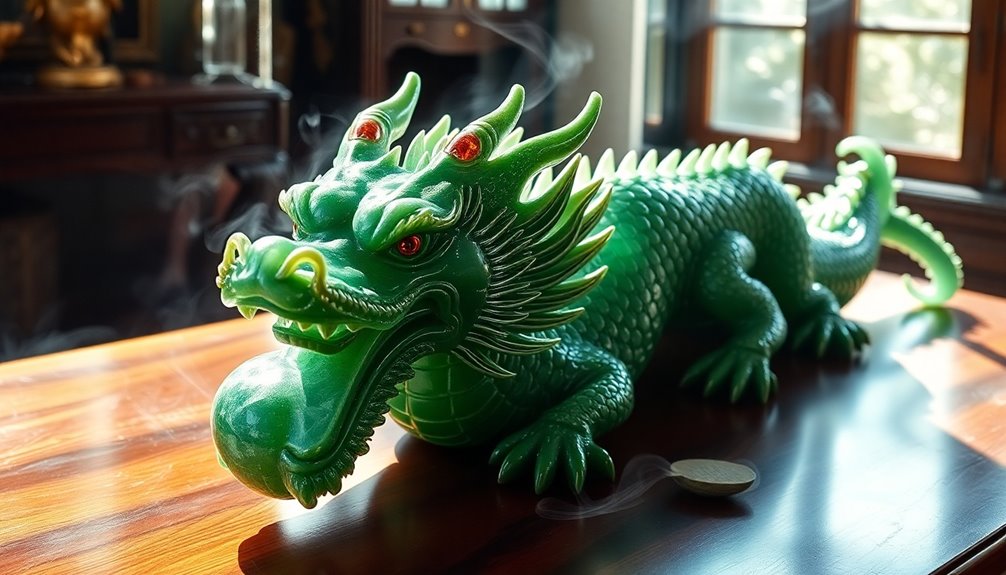Dropping things isn't just an accident; it's often a call to introspection. Each time you let something slip, it might reflect emotional burdens you need to release. For instance, dropping a sentimental item signals a need to let go of past attachments. Such moments ask you to observe your emotional state and identify patterns. Practicing mindfulness can enhance your self-awareness, helping you understand these instances better. By reflecting on what you drop, you can reveal valuable insights into your personal growth. Discover how these lessons can lead to a more authentic, fulfilling life ahead.
Key Takeaways
- Dropping items often symbolizes the need to release emotional burdens and past attachments for personal growth.
- Each incident serves as a reflection point to assess emotional states and identify unresolved issues.
- Mindfulness practices, such as journaling and meditation, enhance self-awareness and promote letting go of what no longer serves.
- Specific items dropped can hold unique spiritual meanings, providing insights into personal growth messages.
- Frequent dropping may indicate a call for spiritual guidance and the importance of balancing physical and emotional health.
Understanding Dropping Things

Dropping things can feel frustrating, but it often carries deeper significance. When you find yourself frequently dropping items, it might signal a lack of concentration or even underlying factors like fatigue or stress that can affect your coordination. Each incident can serve as an opportunity for self-reflection, pushing you to evaluate your emotional state and life direction.
Consider the context of what you drop; specific items can hold unique spiritual meanings and messages. For instance, dropping a phone could symbolize a need to disconnect from distractions, while a piece of jewelry might represent a loss of personal value.
Keeping a journal to track these instances can help you identify patterns and recurring themes, fostering your personal growth and raising your spiritual awareness.
This practice encourages you to recognize the interconnectedness of your physical and spiritual aspects. Each dropped item can reflect both your emotional struggles and potentially divine communication. Embracing these moments as lessons in letting go can enhance your journey toward understanding the messages life sends your way.
Spiritual Interpretations of Dropping

Every time an object slips from your grasp, it may hold a message about your emotional and spiritual state. Dropping items often symbolizes a need for letting go of emotional burdens or toxic relationships, nudging you toward personal growth. Each incident carries spiritual meanings that deserve your attention, reflecting unresolved conflicts or a call for mindfulness in your life.
These moments can serve as guiding signs, suggesting new directions or opportunities for transformation. Pay attention to the context surrounding each dropping incident; the item dropped and the circumstances can reveal deeper spiritual significance.
For instance, dropping a sentimental object might indicate a need to release past attachments, while a work-related item could signal stress and the need for balance.
Keeping a journal to track instances of dropping things helps reveal patterns in your emotional states and spiritual growth. By doing so, you tap into your inner wisdom, allowing you to understand the lessons embedded in these experiences.
Embrace these moments as invitations to explore your inner landscape and foster transformation in your life.
Practical Steps for Interpretation

To interpret the spiritual meaning behind dropping things, start by keeping a journal to track patterns and insights.
Incorporating mindfulness meditation can help you reflect on your feelings during these moments.
Additionally, seeking guidance from spiritual advisors can offer valuable perspectives that enhance your understanding and growth.
Journaling Patterns and Insights
Journaling about instances of items falling from your hands can reveal significant emotional patterns and insights. By documenting these occurrences, you'll start to notice themes related to your emotional states, enhancing your personal reflection and self-awareness.
Here are some practical steps to get started:
- Record Context: Note where and when each incident occurs, along with your mental state. This can highlight underlying issues. Additionally, maintaining a structured routine can help you better manage your emotional responses to these events. Understanding the importance of clear communication can also aid in processing feelings associated with these experiences. Recognizing the role of emotional regulation can further support your journey towards managing these occurrences.
- Identify Patterns: Look for recurring themes or triggers in your entries. Do you drop things more during stressful times? Recognizing such patterns can be crucial in protecting energy during chaotic moments.
- Reflect Regularly: Set aside time to review your journal entries. This can deepen your understanding of your emotional landscape and help you spot stressors. Engaging in mindfulness practices may further enhance your self-awareness during this reflection process.
- Seek Feedback: Share your insights with trusted friends or spiritual advisors. Their perspectives can clarify the spiritual meanings behind your experiences.
Additionally, consider incorporating techniques from stress management techniques to help you cope with the emotions that arise from these experiences.
Mindfulness Meditation Practices
While you mightn't always realize it, mindfulness meditation practices can greatly enhance your awareness of emotional states linked to dropping items. By engaging in daily mindfulness exercises, you can cultivate self-awareness and stay present, reducing distractions that often lead to these incidents. This practice can be likened to how AI systems utilize algorithms to process data and make decisions, emphasizing the importance of understanding underlying patterns.
Moreover, participating in online communities can provide additional support and encouragement during your mindfulness journey, as shared experiences foster resilience and motivation. This practice helps you identify personal triggers, such as stress or fatigue, that contribute to dropping behavior. Incorporating mindfulness meditation into your routine promotes emotional regulation, allowing you to address underlying issues more effectively.
As you meditate, focus on your breath and observe your thoughts without judgment. This creates space for reflection and insight into why you may drop things in the first place.
Additionally, keeping a journal to document your feelings during these moments can reveal patterns and recurring themes. This deeper exploration aids in spiritual interpretation and encourages a connection with your intuition.
Trusting your inner wisdom can provide valuable insights about the messages behind dropped items, transforming a simple act into a profound learning experience. Furthermore, embracing the Law of Attraction can enhance your ability to manifest positive outcomes as you learn to let go of what no longer serves you.
Seeking Spiritual Guidance
When you find yourself frequently dropping items, it's a sign that seeking spiritual guidance can offer clarity and insight. This phenomenon may point to deeper emotional states or unresolved issues in your life.
Here are some practical steps to help you interpret these experiences:
- Keep a Journal: Document instances of dropping items to identify recurring patterns. Reflect on the emotions you felt during those moments to gain insights into your mental state. Additionally, consider how maintaining high vibrational energy can impact your overall awareness and presence. Furthermore, it may be beneficial to assess any cognitive decline that could be contributing to these experiences.
- Mindfulness Meditation: Engage in meditation after dropping something. This practice fosters self-awareness, allowing you to explore your thoughts and feelings related to the incident.
- Consult a Spiritual Advisor: Seek guidance from a spiritual advisor or mentor. They can provide personalized insights into the significance of these events and how they relate to your personal growth.
- Reflect on Emotional Baggage: Use these moments to reflect on unresolved issues. This can encourage proactive steps toward letting go and healing, enhancing your understanding of the interconnectedness between your body and spirit. Additionally, consider the importance of emotional intelligence in navigating these feelings and developing resilience.
Examples of Spiritual Meanings

Dropping items can often be a profound reminder of the spiritual messages life sends your way. Each incident carries spiritual meanings behind your experiences, revealing valuable lessons you might need to embrace.
For instance, if you drop your phone, it could signal a need to release your attachment to technology, urging you to focus on personal relationships or self-reflection.
Similarly, dropping a book might invite you to explore new ideas or broaden your perspective, emphasizing the importance of continuous learning.
If a glass of water slips from your hands, it may symbolize emotional instability, highlighting a need for introspection and balance in your life.
When you drop specific items, like an egg, it serves as a poignant reminder of life's fragility, encouraging you to handle opportunities with care.
The context surrounding each dropped item provides additional insights, emphasizing unique messages related to personal growth and transformations. Engaging with these spiritual messages can cultivate a deeper understanding of your life experiences, fostering resilience in the face of challenges.
Balancing Physical and Spiritual Insights

Understanding the connection between physical and spiritual experiences is essential for holistic healing. When you find yourself frequently dropping things, it can serve as a reminder to pay attention to both your physical health and spiritual well-being.
Here are some ways to balance these insights:
- Acknowledge Physical Symptoms: Be aware of factors like fatigue or stress that may indicate underlying issues needing attention.
- Explore Emotional Implications: Reflect on how dropping items makes you feel; this can reveal deeper emotional connections.
- Use Mindfulness Practices: Engage in meditation or mindfulness to explore the physical sensations and emotions tied to dropping things.
- Keep a Journal: Track your experiences with dropping items to identify patterns that may highlight important messages.
Additionally, recognizing the impact of sleep deprivation on emotional regulation can provide further context to your experiences and enhance your overall well-being.
Embracing Growth Through Letting Go

Letting go isn't just about releasing what's holding you back; it's a powerful step towards embracing new beginnings.
By shedding emotional burdens, you cultivate inner strength and open yourself to fresh opportunities that align with your true path.
This process of release can transform your life, guiding you toward personal growth and spiritual fulfillment.
The Power of Release
Embracing the act of release opens the door to profound personal growth and transformation. When you let go of emotional burdens and toxic influences, you create space for new opportunities and deeper self-awareness.
Here are some key benefits of releasing attachments:
- Fosters Freedom: Letting go allows you to pursue a life that aligns with your divine intentions and authentic self.
- Enhances Clarity: As you release, you gain clarity about your desires and goals, enabling focused personal growth.
- Encourages Transformation: Dropping what no longer serves you can lead to significant life changes and new beginnings.
- Promotes Joy: Embracing the concept of release turns perceived losses into gateways for joy and fulfillment.
Engaging in practices like journaling and meditation supports your understanding of the emotions tied to letting go.
This spiritual discipline not only cultivates self-awareness but also allows you to transform your life. By embracing the power of release, you pave the way for renewal and personal development, opening yourself up to the blessings that come from letting go.
Embracing New Beginnings
New beginnings often spring from the courage it takes to release what no longer serves you. When you let go of something that weighs you down, you open yourself to new opportunities and personal growth. AI-driven education programs can also support your journey by providing tailored resources that facilitate this transformative process.
Releasing attachments, whether they're emotional, physical, or mental, can lead to profound emotional release, helping you unburden yourself from past experiences that hold you back. Additionally, acknowledging your need for self-care can enhance the process of letting go, allowing for deeper healing.
As you acknowledge what needs to be released, you'll find clarity and joy emerging from the process. This clarity allows you to align your life with your true purpose, paving the way for exciting life transformations.
Embracing new beginnings means embracing change, viewing these moments not as endings but as fresh starts filled with potential. Cultivating resilience and adaptability becomes key during these times. Each step you take towards letting go empowers you, transforming feelings of loss into renewed strength. Additionally, practicing self-awareness can enhance your ability to recognize what truly needs to be let go, promoting deeper personal growth.
Cultivating Inner Strength
Recognizing the act of dropping items as a metaphor for releasing emotional burdens can be a powerful catalyst for personal growth. Each time you let go, you create space for inner strength and resilience to flourish. This process encourages you to embrace transformative experiences and adapt to life's uncertainties. Additionally, the power of imagination can help you envision the possibilities that await when you release what no longer serves you. The practice of mindfulness further enhances your ability to navigate emotional challenges, much like those faced by individuals with Borderline Personality Disorder (BPD). Individuals with BPD often struggle with emotional dysregulation, which can intensify feelings associated with letting go. Moreover, understanding the concept of emotional alignment can assist you in maintaining focus and positivity during this transformative journey.
To cultivate your inner strength through letting go, consider these mindfulness practices:
- Journaling: Write about your feelings related to dropping things to uncover patterns and emotional burdens.
- Meditation: Spend time in quiet reflection, focusing on the sensations of letting go and the freedom it brings.
- Spiritual Teachings: Engage with texts that explore the spiritual meanings behind letting go, fostering trust in the universe's plan.
- Consistent Reflection: Regularly assess instances of dropping items to identify underlying emotional struggles, empowering you to confront challenges head-on.
Additionally, letting go of material possessions can be likened to assessing your net worth and recognizing what truly adds value to your life.
Frequently Asked Questions
What Does It Mean When You Keep Dropping Things?
When you keep dropping things, it might signal underlying issues like fatigue or lack of focus.
You should evaluate your health and daily habits to identify potential causes. It could also be a reminder to slow down and be more mindful in your actions.
Tracking when and why you drop items can reveal patterns, helping you understand if there's a deeper connection to your emotional state or overall well-being that needs attention.
What Is the Spiritual Meaning of Letting Go?
Imagine holding onto a heavy backpack filled with stones; every stone represents a burden you carry. When you let go, you lighten your load.
The spiritual meaning of letting go is about releasing these emotional weights, allowing you to embrace freedom and clarity. It's about trusting life's journey and creating space for new opportunities.
What Is the Spiritual Significance of Losing Things?
Losing things often holds deeper significance. It might be the universe nudging you to reassess what matters most in your life.
When you misplace an item, it can prompt you to reflect on your priorities and emotional burdens. If you're repeatedly losing the same thing, it might indicate a lesson you need to learn or a pattern you must address.
Embrace these moments as opportunities for growth and self-discovery.
Why Are Things Falling Out of My Hand Spiritual Meaning?
When things fall from your hands, it might feel like a clumsy accident, but consider it a symbol of release.
You're being nudged to examine what you're holding onto too tightly. These moments can reflect distractions or emotional burdens that need addressing.
Instead of brushing it off, pay attention to what's happening in your life. Journaling these instances could reveal patterns, guiding you toward clarity and personal growth.
Conclusion
In our journey of growth, dropping things can symbolize deeper lessons about letting go. Did you know that studies show nearly 70% of people struggle with attachment, impacting their happiness? Embracing the spiritual meaning behind these moments can help you release what no longer serves you, fostering personal growth and freedom. So next time you drop something, take a moment to reflect—it's not just a mishap; it's an opportunity for transformation and healing.











